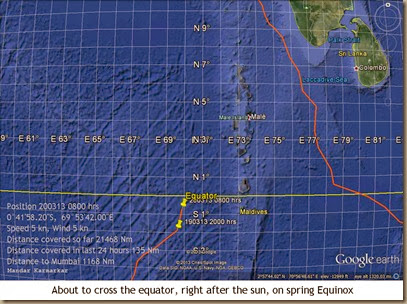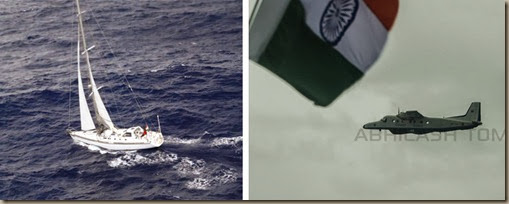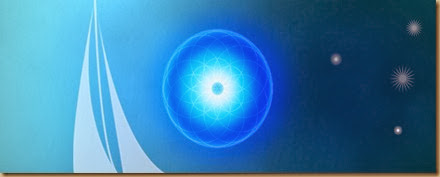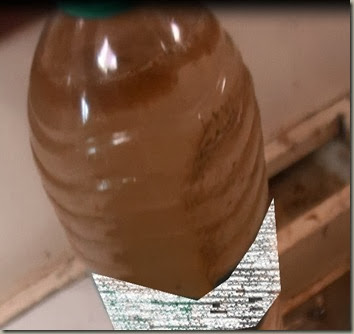 The route from Africa to India is well laid out and all that one needs to do is hop from island to island not unlike ancient navigators and their pilots who relied on the same wind to propel their ships that fills my sails today. The first to pass was Madagascar, an outrageously beautiful island that had been the first country I had visited outside of India when I was still a cadet with pockets brimming with Malagasy Francs that had suffered the natural effects of abnormal inflation. Further east, within sniffing distance, is the Mascarene Archipelago whose volcanic islands and banks and shoals have been in a constant state of slow dance, appearing on one hand and disappearing from the face of the ocean on the other mimicking the movement of scales over millions of years. My route took me through an imaginary gate formed by the main island of Mauritius and Rodrigues and when I was still east of Corgados Carajos on the 11th a Dornier from the National Coast Guard of Mauritius gave fly past. I could tell that the bird was happy to see its pilot in a boat at sea. The next day Mauritius celebrated its National Day and I was still transiting past the outlying Mauritian island of Agalega when I decided it was a good occasion to celebrate one of the three packets of pop corn that I had discovered after an exploratory streak in the boat.
The route from Africa to India is well laid out and all that one needs to do is hop from island to island not unlike ancient navigators and their pilots who relied on the same wind to propel their ships that fills my sails today. The first to pass was Madagascar, an outrageously beautiful island that had been the first country I had visited outside of India when I was still a cadet with pockets brimming with Malagasy Francs that had suffered the natural effects of abnormal inflation. Further east, within sniffing distance, is the Mascarene Archipelago whose volcanic islands and banks and shoals have been in a constant state of slow dance, appearing on one hand and disappearing from the face of the ocean on the other mimicking the movement of scales over millions of years. My route took me through an imaginary gate formed by the main island of Mauritius and Rodrigues and when I was still east of Corgados Carajos on the 11th a Dornier from the National Coast Guard of Mauritius gave fly past. I could tell that the bird was happy to see its pilot in a boat at sea. The next day Mauritius celebrated its National Day and I was still transiting past the outlying Mauritian island of Agalega when I decided it was a good occasion to celebrate one of the three packets of pop corn that I had discovered after an exploratory streak in the boat.
The relentless trade winds had aided a quick but rough passage and the sea remained in a state that can best be described as washing machine conditions. Almost towards its end and only slightly north of Mauritius we entered the ITCZ where it rained “as if it were the middle of the century” and I showered for the first time in the Indian Ocean on the return leg. As we climbed further up the ladder of latitudes, we studiously avoided passing too close to Nazareth and Saya de Malha banks of the Mascarene plateau, names that are not recalled fondly for I had run into their shallows due to logistic reasons on a similar passage from Cape Town to Goa two years ago. From there the island chain veers off towards Seychelles like a stretched bow but that is not where I was headed.
 |
| The Dornier flypast, National Coast Guard, Mauritius |
Close to the banks, I ran into a providential day that suited well for attempting to rig up a new genoa because the trade winds were breathing out its last puffs of gust and winds slated to change north-westerly. My first choice had been the oldest sail in the suite- a spectra carbon genoa that was chosen over newer sails for its cut and weight and the fact that it could be easily furled. Moreover, when I had torn a dacron genoa at a similar place in an earlier voyage, it was this sail that I had turned towards for carrying me all the way back to India. Notwithstanding the emotional attachment, it seemed to have been a costly mistake because midway through the evolution of rigging the sail I saw many gashes appearing on it as its strands withered away due to the severity of its old age and mould infections. I took off the spectra carbon and rigged a dacron sail in its stead in the rising heat and by evening when the sun was down the horizon the second packet of popcorn opened.
Soon winds picked up and under the influence of the north-westerly breeze we negotiated the trenches that divide the African Mascarene Archipelago from the Asian islands of Maldives which merge into Lakshadweep and then into the Indian sub continent. In the game of snakes and ladders we have been rolling our dice well because days of pouring over weather charts have resulted in the fortunate discovery of the existence of a narrow and fleeting corridor through the doldrums.We crossed it at that point where it was the thinnest and were out of it in a matter of twelve hours.
 |
| Crossing the Equator on Spring Equinox |
This voyage, as any other circumnavigation, has more or less been about racing the sun through the southern hemisphere as it cleared a passage through the Southern Ocean in southern summers. On the 1st of November when I started the voyage, I had already allowed the sun a head start. While it had to travel only as far south as a little more than 23 degree South, I had to voyage all the way down to 56 degrees south to round the Horn. The difference between the sun and us had started narrowing quickly only once we hit the trades and were scudding northwards eating away all those latitudes. It was only when the heat began to show that I realised I had been gaining in the race after the sun on its northward transit and on the 20th of March, the day of Spring Equinox, when we finally caught up with the sun I allowed it to cross the Equator ahead of me out of respect for the rigidity of its habit. This time around, I was lavish with offerings of pop corn and Desmond Ji agave.
 |
| A sealed bottle of contaminated water |
Unknown to me, there was another race brewing within the confines of the boat- one that would prove to be a minor crisis which could possibly become a reason for me to seek external assistance. On the 17th of March I discovered that the water tanks that still held about 200 litres of fresh water had been so severely contaminated that I could not even discharge it out into the sea for fear of setting off a marine tragedy. I took stock of the sealed fresh water bottles only to discover that many had leaked out and others had shown signs of severe contamination. The bottles that I could implicitly trust numbered not more than ten which at best could be stretched to last the same number of days in this weather. I let my exploratory zeal search the boat for any fluid that could be consumed and I came back with a packets of coconut milk, Red Bulls and life expired buttermilk. But then during the last monsoons when the boat was moored alongside at Goa, I had decided to harvest rain water on the boat instead of relying on a supply from the shore and I remembered having succeeded quite well at it. I rigged up the bimini and mainsail to trap water and managed a modest yet precious five to ten litres is passing light squalls and all of a sudden I had become a rich man with a lavish reservoir and twice the endurance as before in this heat. But it remains to be seen who outlasts whom and who wins the race to Mumbai- fresh water or the voyage.
The heat of March is unlike the heat of November because it is robbing me of sleep and incepting hallucinatory dreams that have been absent in the other two oceans. In the beginning of March the moon was still in wane and arm of Milky Way was so brilliantly visible that it could have possibly added to the lucidity of dreams. But by the middle of the month, the moon had started to wax and add to the heat of the sun by day and hide the Milky Way by night. Most of the while I would carry on with work like a zombie and any attempt at rest would make my head feel like a squeezed out towel.
PS: This post is dedicated to the patron saint of blogs and dogs!

